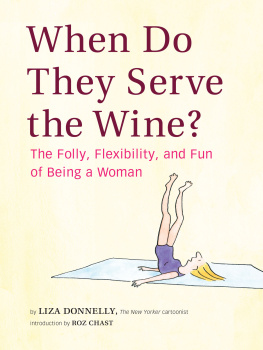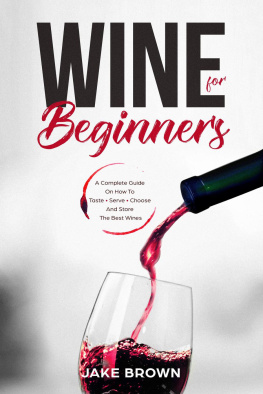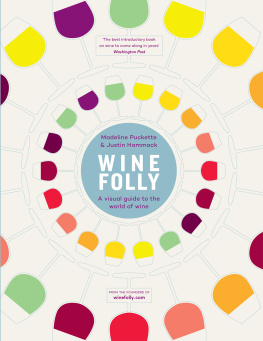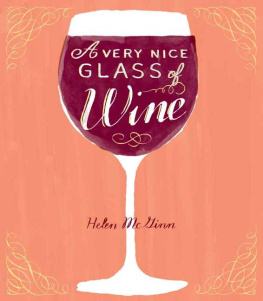 For my daughters, Ella and Gretchen
For my daughters, Ella and Gretchen
By Roz Chast, staff cartoonist, The New Yorker

Some wine with your vest? Ive known Liza since we were both fledgling cartoonists in the late 1970s. We were in our early 20s, single, and living in New York City in semi-genteel, semi-ramshackle apartments on the Upper West Side. We met while submitting work to The New Yorker and, as we became professional cartoonists, we also became friends. We have seen each other through many aspects of life as a woman: dating and boyfriends; building careers from scratch; weddings, husbands, and marriages; getting and being pregnant; living the single life in the city, living the family life in the burbs; seeing our kids speed from preschool through college; and beyond. I still remember my first visit to the cartoon department of The New Yorker quite well. You didnt just walk in there.
You had to be invited by Lee Lorenz, the art editor at that time. Unknown cartoon-ists dropped off their work with the woman manning the little glass-enclosed booth on the 20th floor. If you were invited to show your work, she buzzed you in, and you got to go back to the cartoon offices. The first office is where the editor, Lee Lorenz, worked. Next there was a small office for his assistant, Anne Hall. The third room was where the cartoonists sat on an old sofa or worn wooden chairs or just stood around, anxiously waiting their turns to go in to see Lee.
The first time I got buzzed in, I looked around the room and noticed it was all guys. It was alsoto my 23-year-old eyesall old guys. I was not at ease. I wanted to show Lee my cartoons and then escape before something terrible happened. Like, maybe someone would say hello and what would I say back? Or, what if no one said hello at all? Or what if someone asked me what I was doing there. And what was I doing there anyway? It was World o Guys back then.
Even my son, who had never been to the cartoon department of The New Yorker, seemed to have intuited this. Once, when he was not quite 3, I asked him what he thought I did for a living. He said: You bring your drawings on the train and show them to the men. When Liza showed up in the cartoon department, it was great just to see another female. I remember she had very, very long hair, and she wore only black-, white-, or off-white-colored clothes. I was impressed that she made unusual, original, and deliberate appearance choices.
She was very quiet and serious. But she had a great laugha laugh that was genuine. Of course, those were just first impressions. Over the years, I realized, to my delight, that I had found a new friend. Throughout the 80s, we came to The New Yorker cartoon department every week to submit work, and afterward, we went out to lunch with the other cartoonists at grungy Midtown restaurants like Chili, Etc. or The Quiet Man.
They made our clothes reek of grease and cigarette smoke. The guys mostly drank beer or the occasional martini or Salty Dog. For a while, for reasons I can no longer remember, Liza and I drank White Russians. Later we smartly switched to the more sensible choice of white wine. We were oftenthough not alwaysthe only gals in the bunch. But, really, it was no big dealwe were all cartoonists together, and we could all make each other laugh.
One of my favorite cartoons of Lizas shows a man and woman standing in a kitchen. The woman, who is pouring some wine into glass, asks the man: Some wine with your vest? Its a terrific cartoon. Keenly observed, sly, understated, and so, so funny. You, the reader, know that when the guy put that vest on, he thought he looked pretty cool. But its not quite working out. Plus, hes got that little ponytail.
The woman is smiling but not in a mean way. Shes really just stating a fact. This is what Liza excels at. She sees people clearly. She has a terrific ear, and a terrific eye. In this book, she observes us as we stumble collectively and individually through our various milestones, on this one-way trip to who knows where.
Liza understands the relationships we have with our friends, our spouses, our parents, and our children. It sounds so geezer to say, but it does seem like just yesterday we were 23 and figuring out our place in the world. And yet here we are, still drawing. And of course still trying to figure out our place in the world. In her 28 years contributing to The New Yorker, Lizas line has been light and agile. In her inimitable deadpan style, she describes the hurdles and hoops we jump over and through at every stage of the game.
From the different types of mothers we might have had, to the different types of women we might turn out to be. From our first kiss, to what we imagine sex is going to be, to worrying about our biological clocks, to the age when you look in the mirror and realize that, for the good of humanity, you will never again wear a teeny-weeny yellow polka dot bikini, at least not in public. To hell with the bikini! Art and humor are ageless. That fact, and this smart book, give me hope. Heres to humor and creativity, and heres to Liza.
Growing Up
When do you know that youre a girl? My mother did not invest a lot of money in pink.
Growing Up
When do you know that youre a girl? My mother did not invest a lot of money in pink.
For one thing, I was her second daughterand in the beginning, she was busy recuper-ating from my dangerously early arrival (three months premature!). As loving as she was, we did not do girly things like shopping or painting nails. The only other girl in the houseexcept for our dog, Sassywas my rebellious sister, whose tactics incited fear and anger. I quickly learned to be the good girl. Amid these women, it became clear that someone had actually wanted a boy. My father took me to baseball games and taught me golfall attention I loved.
It became a running joke in the family. At some point, I discovered drawing, and it has saved me. I learned that being a girl was secondary to my concerns, and I positioned myself quietly on the outside of it all. My cartoons were my identity, and they did the talking/dressing/expressing for me. It has been quite a journey since.
20s
When I moved to New York City in 1977, I had really long blonde hair.
20s
When I moved to New York City in 1977, I had really long blonde hair.
I mean, down-below-my-waist long. I loved that my hair got attentionand it hid my curves, which I had grown to hate. I wore Earth shoes and refused to wear makeup, paint my nails, or read womens magazines. It was my rebellion of sorts. But it was also a cop-out. Since my hair said female in volumes, I did not have to acknowledge my womanness.
But there came a time when I realized I had to cut it. I had never been to a salon before. Clueless, I just picked one near my apartment. When I walked in, the stylist stared at me with a combination of utter disgust and glee, and showed me to the chair. What happened next was a blur. I had finally come of agein a hair salon.
For the next 10 years, I cartooned and dated. I was finding my voice in what I created, how I looked, and who I was with. I tried to find that elusive middle groundthat perfect mix of smart, creative, ambitious (but not too), thoughtful, funny, attractive. I spoke very little, fearful my words would betray my lack of confidence. I dated a lot, and my careerwhile successfullurched along. But nothing fit rightI found myself casting aside clothing, men, and cartoons on a weekly basis.










 For my daughters, Ella and Gretchen
For my daughters, Ella and Gretchen Some wine with your vest? Ive known Liza since we were both fledgling cartoonists in the late 1970s. We were in our early 20s, single, and living in New York City in semi-genteel, semi-ramshackle apartments on the Upper West Side. We met while submitting work to The New Yorker and, as we became professional cartoonists, we also became friends. We have seen each other through many aspects of life as a woman: dating and boyfriends; building careers from scratch; weddings, husbands, and marriages; getting and being pregnant; living the single life in the city, living the family life in the burbs; seeing our kids speed from preschool through college; and beyond. I still remember my first visit to the cartoon department of The New Yorker quite well. You didnt just walk in there.
Some wine with your vest? Ive known Liza since we were both fledgling cartoonists in the late 1970s. We were in our early 20s, single, and living in New York City in semi-genteel, semi-ramshackle apartments on the Upper West Side. We met while submitting work to The New Yorker and, as we became professional cartoonists, we also became friends. We have seen each other through many aspects of life as a woman: dating and boyfriends; building careers from scratch; weddings, husbands, and marriages; getting and being pregnant; living the single life in the city, living the family life in the burbs; seeing our kids speed from preschool through college; and beyond. I still remember my first visit to the cartoon department of The New Yorker quite well. You didnt just walk in there.